|
|||
|
Some theme park attractions have an optional single rider line. Flying Saucers at Yesterland has only a single rider line — but it’s not called that. It’s simply “the line.” The ride is designed for every rider to have a solo vehicle (although sometimes two kids squeeze into one). |
|||

Photo by Charles R. Lympany, circa 1962, courtesy of Chris Taylor Space-age sign tower |
|||
|
If you’ve never looked at this ride closely, you might think it’s just a colossal air hockey table with a fleet of ride vehicles that can scoot above it. But it’s much more complicated — and much more ingenious — than that. |
|||

Photo by Charles R. Lympany, circa 1962, courtesy of Chris Taylor Air hockey table? |
|||
|
The Flying Saucers ride uses a big blue oval, bisected into two halves, each with thousands of round air valves, Each half has a movable arm. There are four fleets of 16 saucers. Unlike other “batch load” attractions, this one loads efficiently. |
|||
|
|
|||
|
Loading and unloading takes place in a neat cluster of two rows of saucers. Sit down on your individual Space Age pod. Hold on to the round handles on either side of your seat. |
|||

Detail from aerial photo of Disneyland, courtesy of Orange County Archives, Knott’s Berry Farm Collection Flying Saucers from above |
|||
|
As the ride cycle begins, a giant arm slowly swings away from the loading area, releasing your group of saucers. Air valves directly below your saucer lift it up. Tilt your body to make your saucer scoot across the ride surface. Wherever you go, your saucer actuates air valves as you pass over them. All the lift comes from below. Your saucer has no moving parts — or, more accurately, you’re the only moving part of your vehicle. You can go remarkably fast. Maneuvering your saucer is easy and intuitive if you’re sitting alone. (When two children share a seat, they need to cooperate.) |
|||
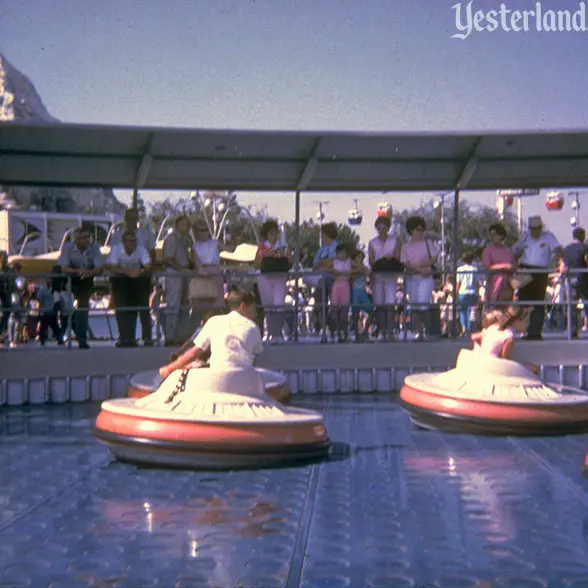
Photo by Werner Weiss, 1966 Saucer photo, taken from a saucer |
|||
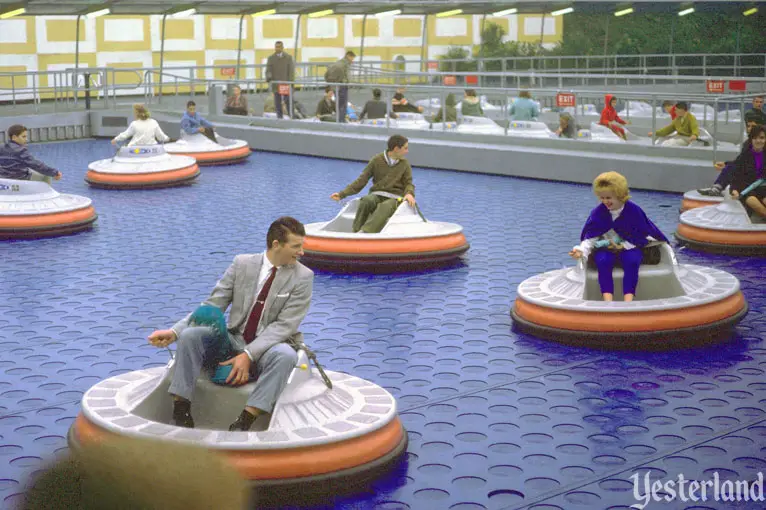
Photo by Charles R. Lympany, circa 1964, courtesy of Chris Taylor Remove your feathered cap, but not your tie |
|||
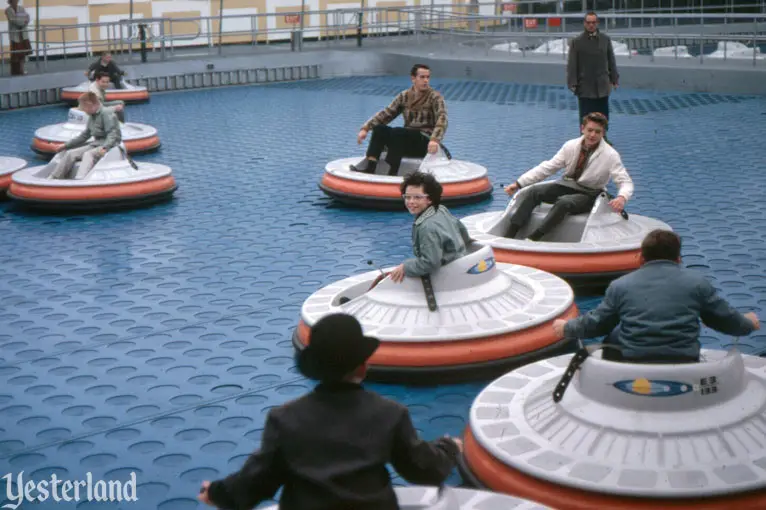
Photo by Charles R. Lympany, circa 1962, courtesy of Chris Taylor Single rider fun |
|||
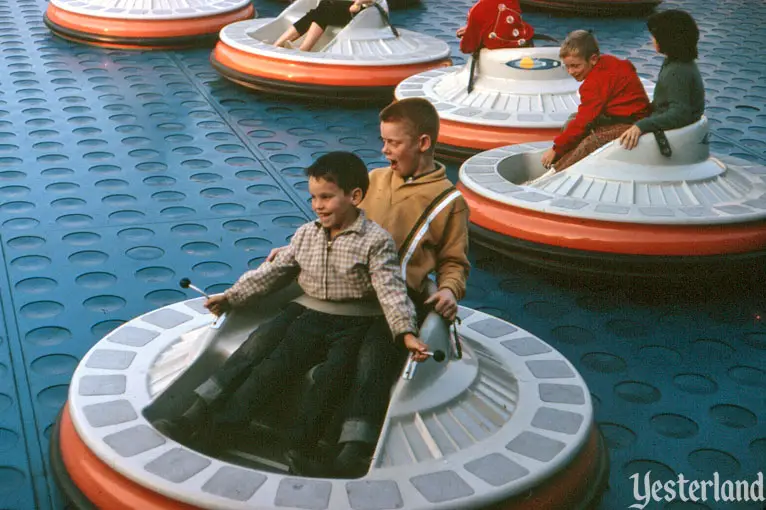
Photo by Charles R. Lympany, circa 1962, courtesy of Chris Taylor Optional tandem seating for kids |
|||

Photo by Charles R. Lympany, circa 1962, courtesy of Chris Taylor Or tight side-by-side seating for those who are narrow enough |
|||

Photo by Charles R. Lympany, circa 1962, courtesy of Chris Taylor Riding while another group of guests loads |
|||
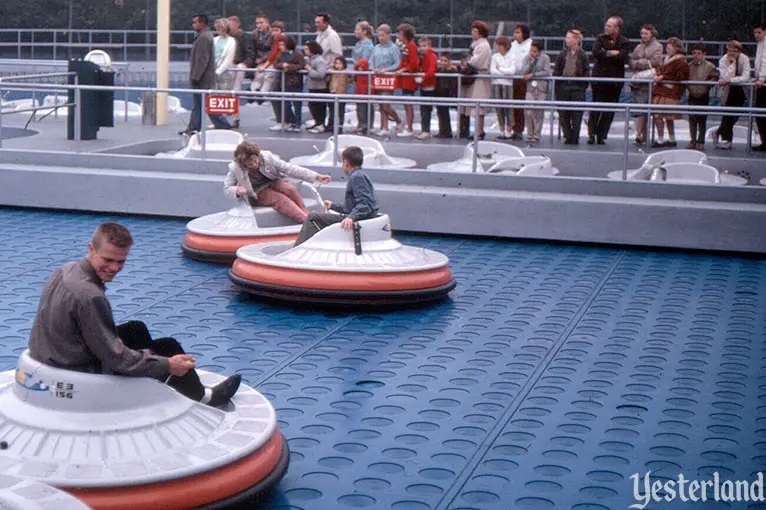
Photo by Charles R. Lympany, circa 1962, courtesy of Chris Taylor Leaning in the direction of travel |
|||
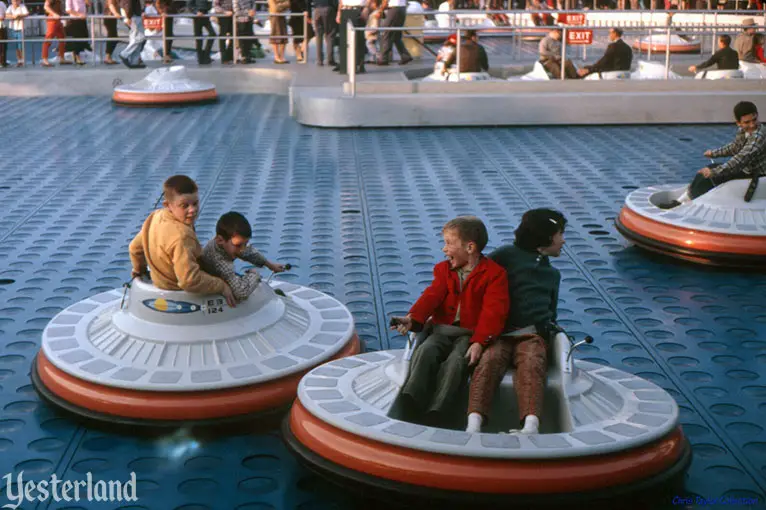
Photo by Charles R. Lympany, circa 1962, courtesy of Chris Taylor Bump! |
|||

Photo by Charles R. Lympany, circa 1962, courtesy of Chris Taylor Traffic jam |
|||
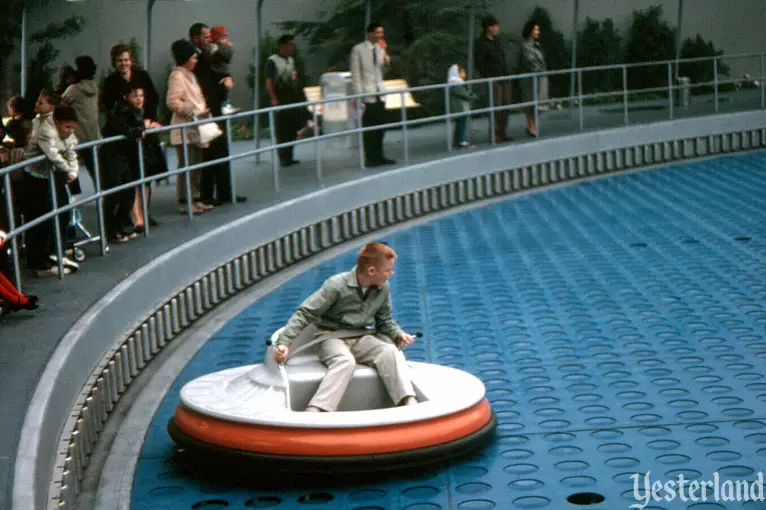
Photo by Charles R. Lympany, circa 1962, courtesy of Chris Taylor Break free from the crowd |
|||

Photo by Roger J. Runck, 1961, courtesy of Robin Runck Floating on air at dusk |
|||
|
Bump into other guests — surprise them from behind! This ride has been called “the bumper cars of the future,” but that’s not entirely apt. Earthbound bumper cars collide with a jarring thump. But these airborne bumping saucers bounce off each other delightfully when they collide. It’s a different sensation. If you sit straight up, you’re likely to find yourself bouncing up and down. So lean in any direction. Scooting and colliding are more fun than bouncing. When your ride cycle ends, the giant arm pushes you back into the loading area, releasing the other fleet of saucers in your half of the oval onto the same ride surface. That was fun! |
|||
|
|
|||
|
Flying Saucers opened at Disneyland on August 6, 1961. Here’s how the Los Angeles Times reported the news in a short article (August 15, 1961): Flying Saucers Now Flit About Disneyland Walt Disney sent aloft 32 flying saucers Monday morning. It figured Disney would eventually get around to constructing a saucer springboard. Disney’s saucer launch pad is the latest attraction at Disneyland. Those aboard the first flights included a man-size Pluto the Pup, a space girl, a space man and two jet pilots from El Toro Marine Base, Lt. Col. J. P. Willcox and Maj. Walt Jacobs. The Flying Saucer ride cost $400,000 to build, Each saucer is “blown” 8 in. off the ground and is under constant control of its pilot. It’s unclear how the Times reporter multiplied 16 by 4 and came up with 32 saucers. Perhaps only half the ride was open. The article also did not note that each “pilot” was a park guest. |
|||
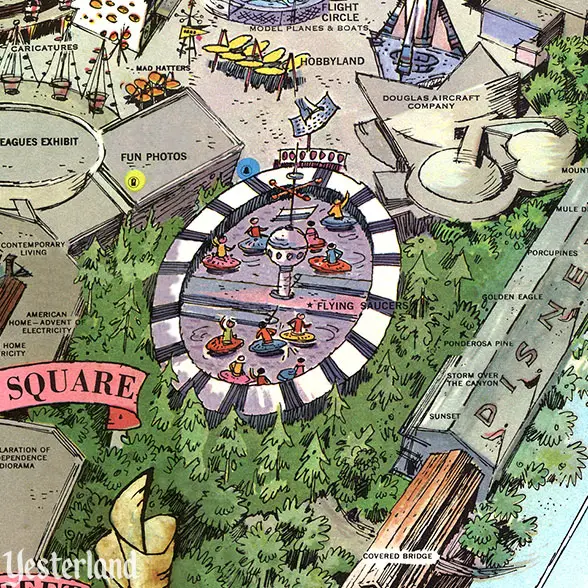
Detail from 1964 Disneyland Souvenir Map © Walt Disney Productions How the Disneyland Souvenir Map showed Flying Saucers |
|||
|
Flying Saucers used patented technology, developed just for this ride. The innovative infrastructure was by Arrow Development of Mountain View, California, while the little saucers were the creative work of Bob Gurr — a rare Gurr design with no moving parts. |
|||
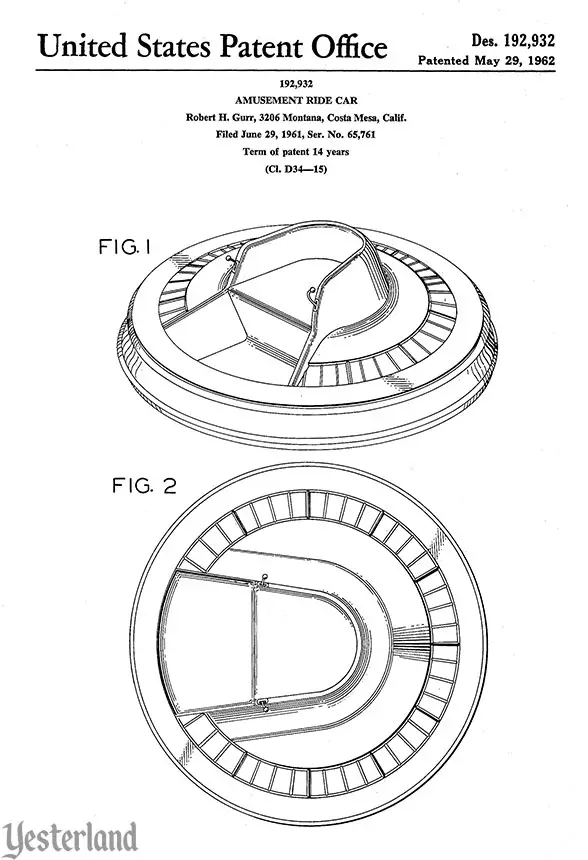
From U.S. Patent number D192932 at Google
Diagram from U.S. Patent for “Amusement ride car,” |
|||
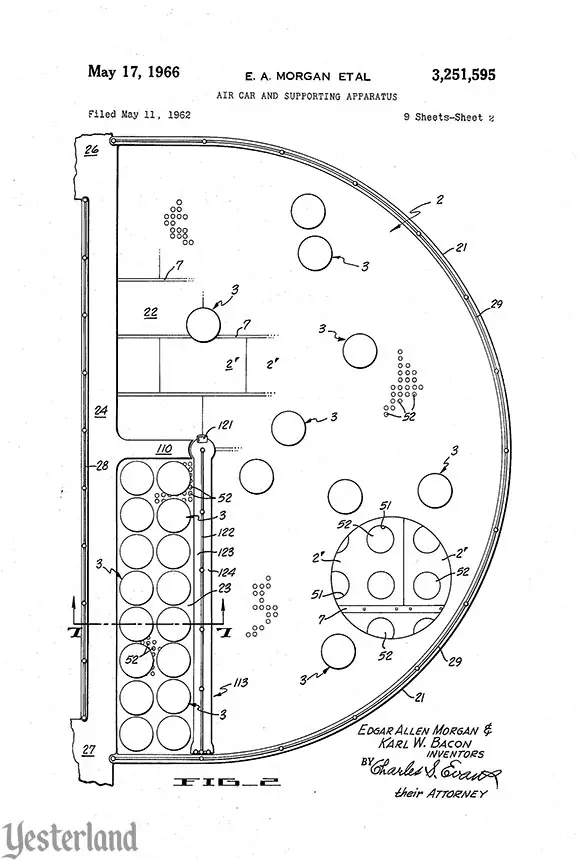
From U.S. Patent number 3251595 at Google
Diagram from U.S. Patent for “Air car and supporting apparatus,” |
|||
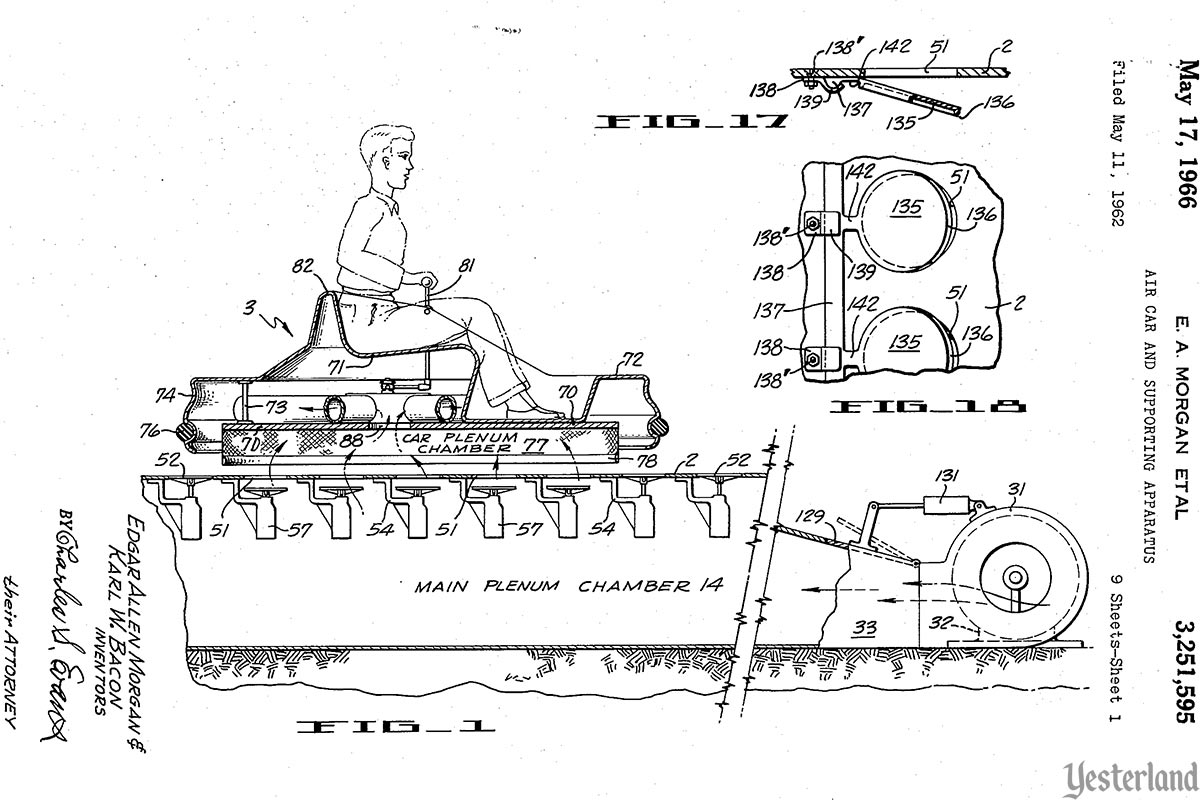
From U.S. Patent number 3251595 at Google Diagram from U.S. Patent, showing how the valves would open only when below a saucer vehicle |
|||
|
Flying Saucers closed on September 5, 1966 — along with much of the rest of Tomorrowland. When Disneyland’s New Tomorrowland opened July 2, 1967, guests found an amazing array of new attractions, including Monsanto’s Adventure Thru Inner Space, the Goodyear PeopleMover, the General Electric Carousel of Progress, Rocket Jets, America the Beautiful in Circle-Vision 360 presented by the Bell System, and Flight to the Moon presented by McDonnell Douglas. But the beloved Flying Saucers ride was nowhere to be seen. In its place, the Tomorrowland Stage offered concerts and shows. Perhaps the absence of Flying Saucers would be temporary. After all, new Disneyland Souvenir Maps showed something called Space Mountain. Would Flying Saucers be on the bottom level of that Space Age marvel? It didn’t happen. Flying Saucers had a run of just over five years, and then never returned to Disneyland or anywhere else. The reason? According to Disney A to Z by Dave Smith (Hyperion, 1998), “Individually controlled vehicles floated on a cushion of air, but the technology was not perfected and the attraction was constantly breaking down. It was one of the worst maintenance headaches at Disneyland, as the technicians continually tried to keep it operating. Eventually, they gave up.” |
|||

Photo by Werner Weiss, 2010 Homage to Flying Saucers on exterior of Innoventions at Disneyland |
|||
|
But wait! Wasn’t Luigi’s Flying Tires (2012 ‐ 2015) supposed to be the return of Flying Saucers — only now with great storytelling, plus 21st Century technology to overcome the original operating headaches? Not really. |
|||
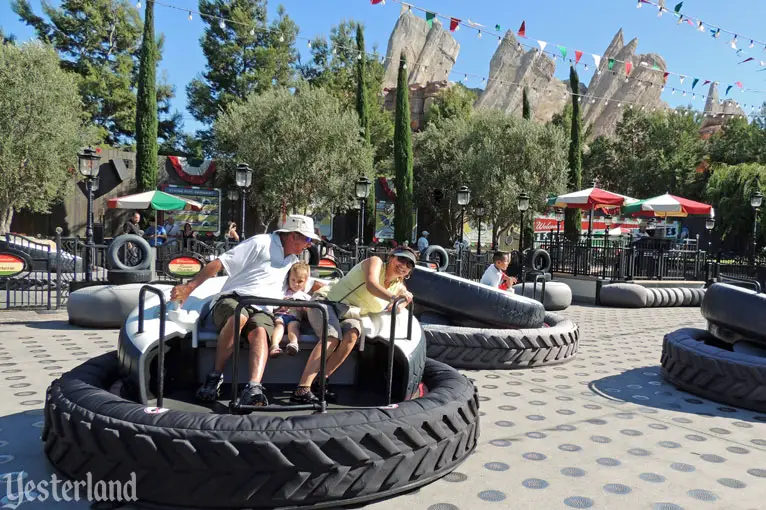
Photo by Werner Weiss, 2014 Not even close to the original Flying Saucers |
|||
|
Luigi’s Flying Tires had clunky multi-rider vehicles, which were difficult to maneuver, slow, and not particularly fun. The single large ride surface made it a slow-loading, low-capacity attraction. The detail-rich indoor queue was the best part. Luigi’s Flying Tires closed permanently February 15, 2015. Its wonderful queue now serves Luigi’s Rollickin’ Roadsters. Maybe, some day, Disney can dust off the old patents and blueprints to bring back Flying Saucers properly — just like the 1961 original, only with computerized process controls to keep the air pressure perfect and the ride operating reliably. |
|||
|
|
Click here to post comments at MiceChat about this article.
© 2024 Werner Weiss — Disclaimers, Copyright, and Trademarks Updated December 6, 2024 |
||
